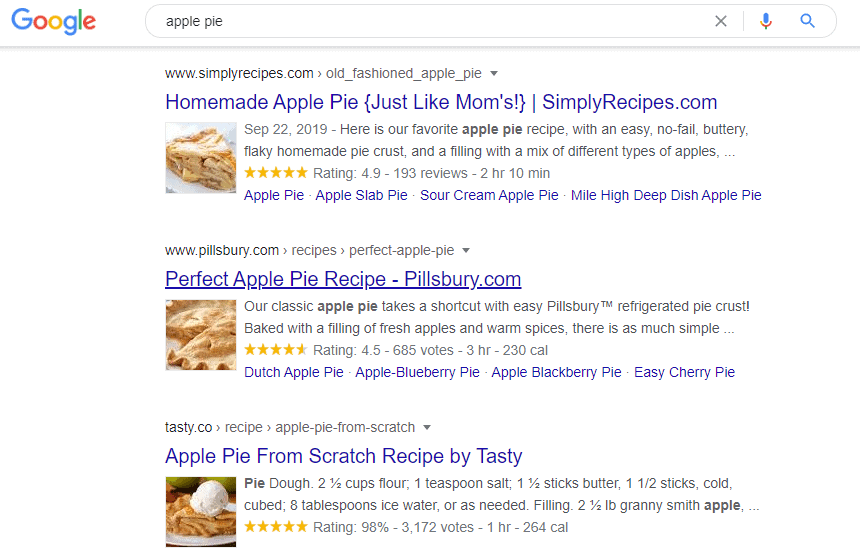Rich Snippets: what they are and how they work
Over time, SERP evolved to become one of the most important battlefields for businesses competing for customers’ attention. To obtain it, the sole optimization of elements such as title and meta description is not enough anymore. You need to optimize more.
What are Rich Snippets?
Rich snippets are elements that add more components to search results on SERP.
Here are some examples:
Product review, price field, author name: they all can be components of a single rich snippet.

Maybe now you’re wondering… what is the use of rich snippets?
On average, rich snippets have a better click-through rate than standard snippets, because they make the user act.
Taking care of your rich snippets can boost your presence on Google, so it is crucial for SEO.
Websites with good, well-organized structured data make the crawling easier and more accurate.
As a result, Google features a rich snippet for your pages, increasing your CTR.
Structured Data
Structured data is designed to help search engines better interpret information. For this reason, its correct implementation is critical to obtain a rich snippet.
Where can we find structured data?
Google, Yahoo, Bing, and Yandex built a basic vocabulary for structured data, valid for every kind of information we want to add to our webpage.
Here are some examples of structured data:
Creative works: such as books, movies, songs, or TV series.
Non-textual: audio files, images, and videos.
Events: help users find the most exciting events in their area through search results and Google Maps.
Health: information about medications, pathologies, symptoms, publications; or advice about therapies.
Organizations: schools, NGOs, or clubs.
People: they may be living, dead, or fictional. It contains information such as the name, date of birth, gender, height, and much more.
Local businesses: can provide a rich snippet with address, opening hours, phone, and busiest hours.
Products: adds the “Product” badge on the images on Google’s images research page for mobile devices.
Reviews: they show the average rating of a product or business. They help users to find reviews and encourage them to visit your website to read the full review.
Actions: are microdata used to identify specific actions performed by an agent to an object.
Testing tools for rich snippets
If you want to know if your website has a good internal structure, you can check the presence of markups through a rich snippet test.
How to perform it? With Google’s Structured Data Testing Tool. Just open the testing page and enter the URL or the code snippet you want to test.
Once you entered the address, you land on the report page. On the left, you can see an HTML document; on the right, the tool shows errors and alerts.
Try Google’s Structured Data Testing Tool.
Besides, you can also check your rich snippets with two other testing tools:
The Structured data Report: You can access it on Google Search Console. It checks the markups on your website and highlights errors.
Data Highlighter: It helps search engines to understand and process structured data. With it, you can highlight and tag data fields.
Work on featured snippets and conquer the zero position!
Besides working on markups, you also should optimize your content. The content optimization can make you conquer the zero position within the SERP.
In this position, your content appears not as a usual result, but as a featured snippet.
What Google’s featured snippets are?
Let’s see what Google has to say about them:
“Google’s search results sometimes show listings where the snippet describing a page comes before a link to a page, not after as with our standard format. Results displayed this way are called “featured snippets. We display featured snippets when our systems determine this format will help people more easily discover what they’re seeking, both from the description about the page and when they click on the link to read the page itself.”
Now you can understand how crucial it is to provide your readers with quality content that can answer their questions.
Featured snippets aren’t paid adverts. Right after Google understood that the query is a question, it scans the pages that could have the answer and shows the most poignant one on the “zero position”.
Why there aren’t rich snippets on my result?
In some cases, the structured data you’ve inserted could not appear on search results.
Here’s why:
- It’s not automatic: like most outcomes in SEO, markups are not a guarantee of a rich snippet on the SERP, whether you’ve inserted the code or not.
- The markups don’t respect the quality standards: if they don’t, Google won’t show your featured snippets on the SERP.
- They don’t reflect the page content: this can hinder the user experience, and you know what happens when Google finds out things like that.
- Vulgar language: your markups don’t appear if they contain rude or unrespectful messages.
- Data entered incorrectly: this is the most common reason for rich snippets not showing. It happens, most of the time, on pages with a product or recipe section. Usually, the reason is a code section closed prematurely.
- Domain not authentic: if Google thinks that your domain is not so reliable, it doesn’t feature the rich snippet on the SERP.
- Not enough time passed: give time to the crawler: it doesn’t discover your web pages instantly, and the same goes for markups. Have a little patience and wait for your rich snippets to show up.
Do you have a Blog on WordPress?
If you have a Blog on WordPress, you can easily set up structured data using one of the hundreds of plugins available. Great news: most of them are free!
Check our list of the best WordPress Plugins for Structured Data.
Do the structured data test with SEO Checker
You can also verify that you correctly implemented the structured data with the SEO Tester Online’s SEO Checker.
It takes seconds: do the test and make sure that you’ve inserted the Schema.org microdata to make your rich snippets appear on the SERP.
Check the structured data on your website with our SEO Checker.






